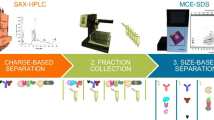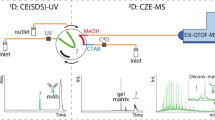Abstract
Staphylococcal protein A (protein A) is an important protein frequently used in research studies within the fields of biomedicine and biotechnology. Due to some limitations in available protein purification methods which can hold the native structure of the protein A without changing the folding or adding histidine to structure of this protein, its separation in the native form is difficult. In this study, a new cost-effective and powerful technique was introduced for separation of the full-length and truncated forms of recombinant protein A, without any alteration in their 3D structures. Per aqueous liquid chromatography with bare silica gel stationary phase and water:acetonitrile as the mobile phase was proved to be an attractive choice among the range of separation methods. Similar to hydrophilic liquid chromatography, this method employs high percentage of water in mobile phase. The effects of mobile phase composition, pH, and salt concentration on the retention behavior of protein A on bare silica gel stationary phases were investigated. In this method, applying high amounts of aqueous solvent accompanied by a minimum percentage of organic solvent could successfully separate protein A with preservation of folding, and any affinity-tagged group such as histidine has not occurred on its structure. Purity of the fractions obtained by the proposed method was confirmed using SDS-PAGE, western blotting, and matrix-assisted laser desorption ionization time-of-flight mass spectrometry. According to the results of ELISA, separated proteins retained their ability of binding to antibody.





Similar content being viewed by others
Change history
04 November 2017
Please correct the sequence of the authors to read as follows:
Abbreviations
- PALC:
-
Per aqueous liquid chromatography
- Protein A:
-
Staphylococcal protein A
- SDS-PAGE:
-
Sodium dodecyl sulfate polyacrylamide gel electrophoresis
- MALDI-TOF MS:
-
Matrix-assisted laser desorption ionization time-of-flight mass spectrometry
- Fc:
-
Fragment crystallizable
- IgG:
-
Immunoglobulin G
- IMAC:
-
Immobilized metal ion affinity chromatography
- HILIC:
-
Hydrophilic interaction liquid chromatography
- ACN:
-
Acetonitrile
- TFA:
-
Trifluoroacetic acid
- BSA:
-
Bovine serum albumin
- PBS:
-
Phosphate buffer saline
References
Graille M, Stura EA, Corper AL, Sutton BJ, Taussig MJ, Charbonnier J-B, Silverman GJ (2000) PNAS 97:5399–5404
Jungbauer A, Hahn R (2004) Curr Opin Drug Discov Devel 7:248–256
Lawman M, Thurmond M, Reis K, Gauntlett D, Boyle M (1984) Vet Immunol Immunopathol 6:291–305
Dossett JH, Kronvall G, Williams RC, Quie PG (1969) J Immunol 103:1405–1410
Balint Jr JP (1991) Purification of protein a by affinity chromatography followed by anion exchange. US5075423
Torres AR, Runkis WH (1999) Simple, environmentally benign, method for purifying protein A. WO1999010370A1
Forsgren A, Sjöquist J (1966) J Immunol 97:822–827
Surade S (2007) Structural genomics on prokaryotic membrane proteins. Johann Wolfgang Goethe-University Frankfurt am Main, Germany
Wu J, FUutowiczK M (1999) Acta Biochim Pol 46:591–599
Schmitt J, Hess H, Stunnenberg HG (1993) Mol Biol Rep 18:223–230
Bornhorst JA, Falke JJ (2000) Methods Enzymol 326:245–254
Louwrier A (1999) Biotechnol Tech 13:329–330
Carroll J, Fearnley IM, Walker JE (2006) PNAS 103:16170–16175
Pedrali A, Tengattini S, Marrubini G, Bavaro T, Hemström P, Massolini G, Terreni M, Temporini C (2014) Molecules 19:9070–9088
Tetaz T, Detzner S, Friedlein A, Molitor B, Mary J-L (2011) J Chromatogr A 1218:5892–5896
Guo Y, Gaiki S (2005) J Chromatogr A 1074:71–80
Knox J, Pryde A (1975) J Chromatogr A 112:171–188
Periat A, Kohler I, Bugey A, Bieri S, Versace F, Staub C, Guillarme D (2014) J Chromatogr A 1356:211–220
dos Santos Pereira A, David F, Vanhoenacker G, Sandra P (2009) J Sep Sci 32:2001–2007
Gritti F, dos Santos Pereira A, Sandra P, Guiochon G (2010) J Chromatogr A 1217:683–688
Ghaedmohammadi S, Rigi G, Zadmard R, Ricca E, Ahmadian G (2015) Mol Biotech 57:756–766
Rigi G, Bahrami T, Armand R, Piruzeh Z (2016) Iranian J Health Sci 4:35–44
Rigi G, Beyranvand P, Ghaedmohammadi S, Heidarpanah S, Noghabi KA, Ahmadian G (2015) J Phram Sci 104:6–11
Rigi G, Mohammadi SG, Arjomand MR, Ahmadian G, Noghabi KA (2014) Biotechnol Appl Biochem 61:217–225
Laemmli U (1970) Nature 227:680–685
Gromova I, Celis JE (2006) Cell biol 4:421–429
Nielsen UB, Geierstanger BH (2004) J Immunol Methods 290:107–120
Hobbs H, Reddy D, Rajeshwari R, Reddy A (1987) Plant Dis 71:747
Parker J, Guo D, Hodges R (1986) Biochem 25:5425–5432
Acknowledgements
The authors would like to thank the National Institute of Genetic Engineering and Biotechnology (NIGEB) of Iran for providing the necessary equipment.
Author information
Authors and Affiliations
Corresponding authors
Ethics declarations
Conflict of interest
The authors have no other relevant affiliations or financial involvement with any organization or entity with a financial interest in or financial conflict with the subject matter or materials discussed in the manuscript, apart from those disclosed. No writing assistance was utilized in the production of this manuscript. The authors declare no conflicts of interest.
Ethical approval
All applicable international, national, and institutional guidelines for the care and use of animals were followed. This article does not contain any studies with human participants or animals performed by any of the authors.
Additional information
A correction to this article is available online at https://doi.org/10.1007/s10337-017-3432-x.
Electronic Supplementary Material
Below is the link to the electronic supplementary material.
Rights and permissions
About this article
Cite this article
Aboul-Enein, H.Y., Rigi, G., Farhadpour, M. et al. Per Aqueous Liquid Chromatography (PALC) as a Simple Method for Native Separation of Protein A. Chromatographia 80, 1633–1639 (2017). https://doi.org/10.1007/s10337-017-3412-1
Received:
Revised:
Accepted:
Published:
Issue Date:
DOI: https://doi.org/10.1007/s10337-017-3412-1




